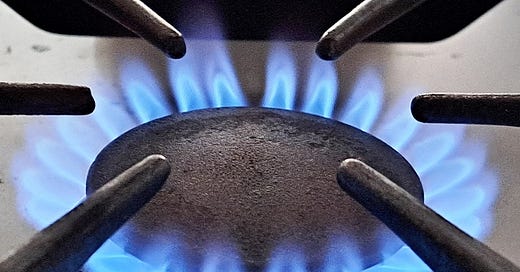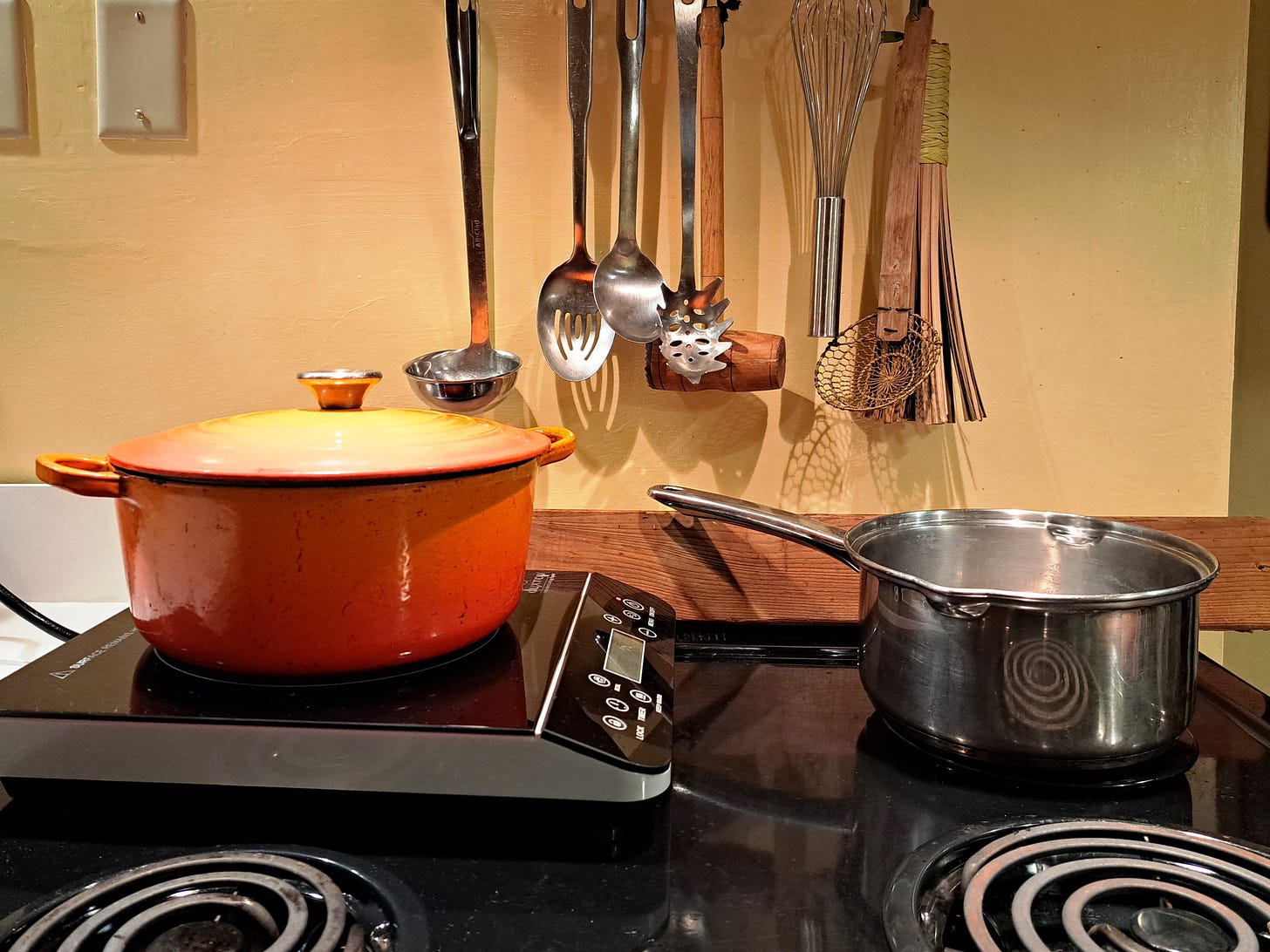I made tea last week on a gas cooker (aka stove) in a friend’s flat in New York. That hiss-click-flare felt so familiar. Seeing the flame on a dark winter morning was comforting. I do understand why people are attached to cooking on gas. In fact, I used to complain about there not being gas laid on in my Great Barrington neighborhood (to get gas, you had to spend many thousands of dollars for an individual hookup).
But as you’ve probably noticed, there has been a virtual explosion of press about the dangers and climate impact of gas cookers over the past few weeks, along with reports that some US states are planning to ban gas stoves because of indoor air pollution.
As a result, certain Republican politicians lost their minds. Even men who believe in Kinder, Küche, Kirche, and are unlikely ever to have cooked a meal, were tweeting about how they would never give up their gas stoves.
The right-wing, as usual, had good messaging for their particular audience. Simple, emotive: Don’t come for my cooker.
But like the row over banning gas-powered leaf blowers, this one’s been complicated by confused messaging on the other side. Is it the environment, or is it children’s health? Is the problem gas itself or the fact that so much methane1 leaks from the system?
And is this really the most important thing? It’s not as if there aren’t plenty of toxins in our environment.2
I was reminded of the Alar scare of the 1990s. Alar is a chemical used to treat apples, and there was a campaign, put together by a PR agency for the National Resources Defense Council, that led to the “environmental kook” story about a mother chasing a school bus to retrieve an apple from her kid’s lunchbox. Reason told us that the lunchbox contained other products that weren’t 100% organic and pure. But it’s so easy to focus on a single scary thing you can fix right now.
Most people can’t afford simply to replace major appliances, and (as I explain below) buying an electric cooker right now may not be a sound choice.
But you can protect yourself and your family. The key thing is plenty of air circulation. Open a window, and use the fan. You may see advice about using an air purifier with a HEPA filter, the kind of thing that is common in homes and offices in China because of the pollution. But most purifiers aren’t designed to deal with gaseous pollutants.
You can, however, use an air quality monitor that detects carbon dioxide. It won’t register the substances a gas stove emits, but it should show how much CO2 is in the air, which you can use as a proxy for the pollutants from the stove. Read “Worried About Your Gas Stove? Here's What to Do.”
Electricity can come from many sources, so as we improve renewable capacity and efficiency, we can keep using the same equipment. This adaptability is a crucial advantage.
It’s the disposal, sweetheart
What happens to all these complex manufactured items if we replace them with new, more efficient ones? This is the question no one seems to want to think about, even though environmentalists have been talking about life-cycle analysis for decades. I was astonished to read a new article from the Sierra Club that doesn’t even mention disposal.
Buying organically grown apples is an easy change, but 100 million people in the EU use gas cookers, including half of all homes in the Netherlands and Italy. In the US, gas stoves are used in about 35 percent of households, about 40 million homes. Imagine if half of us “ditched,” as the Sierra Club article put it, our tens of millions of stoves. Where would they go? Where would all the material come from to make the new ones?
The solution to this is called remanufacturing, a system that is relatively developed in a few industries. Remanufacturing deserves much more attention and investment.
Small steps
In the meantime, a simple thing to do, which can pay for itself quickly, is to use small electric appliances instead of your gas cooker. Air fryers are one example. They are not really fryers: they are small convection ovens. Or you may prefer, as I do, a countertop convection oven. I use mine all the time. It’s big enough for a pie, a souffle, two regular-sized loaves of bread, or a small roast chicken.
These appliances are a great addition if you have the space, and will make it easy to reduce the use of your gas cooker. And they pay for themselves quickly if you really make use of them. It’s important to think about what you actually need, rather then splash out on more appliances that will gather dust.
Then there is the next wave: induction technology, which draws electricity but heats food using the magnetism of ferrous metal cookware to heat the pot itself directly, and almost instantly. I am experimenting with a single induction cooktop (photo above) that cost less than $100. Fortunately, most of my cookware is plain or enameled cast iron, which works perfectly on both the woodstove and on the induction cooktop. Not all cookware will work. Copper and aluminum are not magnetic, and stainless steel is a mixed bag: it depends on the metal content of the pan’s bottom.
Induction, and no doubt other technologies, is the future, so wide-scale replacement of gas stoves with ordinary old-style electric stoves hardly seems a rational path.

Cooking on a wimpy stove
How about cooking, especially the kind of cooking that gas stoves are best for? I associate gas cookers with Asian cooking, or stir-frying.
When your crummy electric burners can barely summon up enough energy to fry an egg, how can you possibly achieve what Grace Young called wok hei in her award-winning book, The Breath of a Wok? The literal translation of wok hei is wok “fragrance,” which is the perfect name for all of the glorious aromas of caramelized sugars, smoky oils, and slightly charred ingredients you get whenever you stir-fry on super-hot iron.
That comes from an article by Carolyn Phillips, whose practical take I’ve long admired, “The Secret to Stir-Frying on a Wimpy Electric Stove.” You can read more at her website or in her new memoir At the Chinese Table: A Memoir With Recipes. I’ll be writing more about Asian cooking, because as this article explains, the traditional Chinese diet offers lessons to a warming world.
Spring is coming!
It was a snowless January in New York, the first since Richard Nixon was president. Apparently the groundhog saw its shadow so we have 6 more weeks of winter. But spring is coming, and the first snowdrops are out.
This newsletter has a section about methane you might find helpful. You can skip the bit about plastic straws.
No, I am not going ive you a list of household toxins. I could, indeed. But we are not going to panic, and we’re taking home ecology step by step.








Here's another example of breaking news on a toxin in our home environment: Do I Need to Avoid Dark Chocolate Now? A recent report found high concentrations of cadmium and lead in dark chocolate. There’s no reason to panic, experts say, but it’s worth a closer look. https://www.nytimes.com/2023/02/09/well/eat/dark-chocolate-metal-lead.html
This is a nice product.